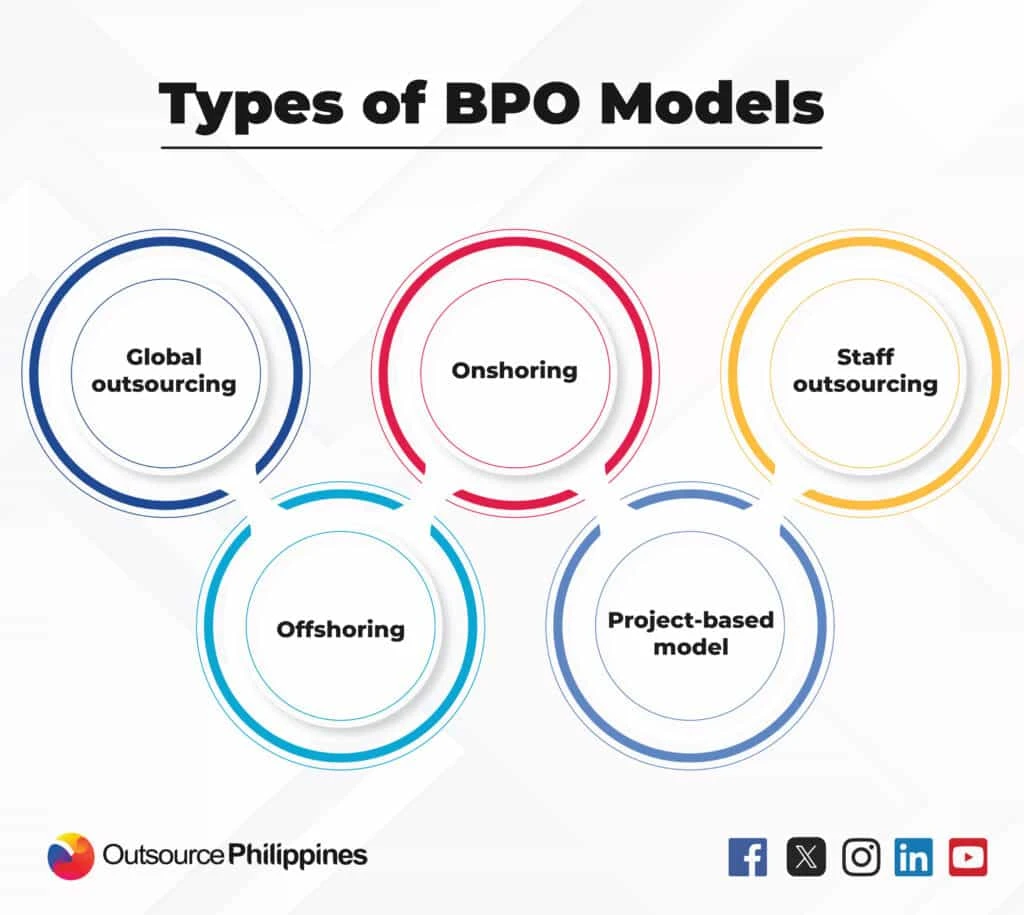
What is Business Process Outsourcing (BPO)?
Business Process Outsourcing (BPO) is a strategic approach where companies delegate specific business processes to external service providers. This allows organizations to focus on their core competencies, reduce costs, and enhance operational efficiency. BPO involves contracting out non-core functions, such as customer support, accounting, and human resources, to specialized vendors. By doing so, businesses can access expertise, technology, and resources that might not be available in-house. This not only streamlines operations but also provides a competitive edge by leveraging the specialized skills and advanced technologies of the BPO providers.
BPO Model: What is It and What are the Different Types?
Managing businesses in their entirety is taxing because it requires a pool of skilled workers just for the business to succeed. This is why companies are drawn to business process outsourcing, which aids in achieving flexible operations. Of course, you want to ensure everything is seamless. However, it is also important to remember that people—the workers—are the most significant part of building an organization.
Every business owner knows how difficult it is to run a company. A lot must be thought through and decided on, so you must prepare thoroughly before starting any business. Nonetheless, you have to remember that things may go sideways. To run a successful business, you must adapt to changing situations. Additionally, regulatory compliance is crucial when selecting a BPO model.
This leads us to large firms that work on huge projects and have employed various BPO models. What are they? As we discuss each BPO model, business process outsourcing type, and vendor type, you will learn which fits your business. Understanding the different business process outsourcing types is crucial for selecting the right model for your business.
What is a BPO model?
Business process outsourcing (BPO) refers to the different ways of handling certain operations and company projects. Since BPO is a method of subcontracting various business-related operations to third-party vendors, the BPO model refers to the different business models for BPO. These models may vary according to service provider capabilities, cost savings, client needs, and expectations.
Related Article:
Types of Outsourcing Services to Consider for Your Business Needs
BPO Models and Types of Vendors
BPO models are concepts of business models related to the BPO industry. An outsourcing business’s operation and client services are generalized in BPO models. The models are constructed based on the client’s goals, needs, and geography. Different BPO models can lead to operational efficiencies by optimizing resources and processes.
To better understand how BPOs work, let’s discuss the BPO models and types of vendors.
Types of Business Process Outsourcing Models
1. Global Outsourcing Model
Most major companies that offer a wide range of services frequently choose this outsourcing approach. To complete large projects, they collaborate with enterprises abroad and in the nation. In this case, clients contract work to several specialist companies in various nations. In addition to benefiting individuals in developing nations, this arrangement benefits both sides. Consequently, the project is profitable for the customer, and service companies will profit greatly from nearshore outsourcing.
2. Joint Venture Model
In this BPO model, two companies signed a joint contract to split assets, earnings, and losses. Additionally, the terms and conditions frequently stipulate that the client company and the service provider will split the personnel, resources, and time until the project is finished.

3. Offshoring Model
In this model, a corporation spreads throughout multiple nations, with the leading company overseeing staff training. In addition to delegating some of their work to an external service provider, they share jobs across the branches. They may use this strategy to maximize their human resources and reduce operating expenses while retaining control over their workflow and service delivery. Additionally, this approach enables the parent company to tap market possibilities and grow closer to clients where they outsource. It is also crucial to consider regulatory compliance when using the Offshoring Model.
4. Project-Based Model
As the name implies, project-based outsourcing benefits businesses with irregular or sporadic tasks. Most projects have low to medium complexity, well-defined objectives, and criteria. Companies outsource them so they may carry on with their usual business operations and, at the same time, pay a dedicated workforce to concentrate on the task. This approach can also lead to faster response times and improved service, directly contributing to higher customer satisfaction levels as businesses scale up. The Project-Based Model can also lead to significant cost savings by optimizing resource allocation and reducing overhead expenses.
5. Staff Leasing Model
Under this BPO model, a corporation outsources a small group of people or a portion of their time rather than a whole team or business. When businesses want the services of higher skilled workers but not on a full-time basis, they frequently pick the option of back office outsourcing. A few engage personnel to provide additional services they lack or if they cannot assemble a new internal team.
The Staff Leasing Model also allows access to a global talent pool.

Download the Types of BPO Models infographic here.
Types of BPO Vendors
The types of BPO providers and vendors vary depending on the location of the BPO firms. Vendor locations, therefore, determine the three segments of the BPO sector and international outsourcing.
- Offshore vendors are located outside the nation where the company is based. A US corporation collaborating with an Australian offshore BPO provider illustrates this.
- Nearshore vendors, on the other hand, are situated close to the nation where the contracting company is based. For instance, a nearshore vendor in the US may be a BPO company with offices in Montreal, Canada.
- Although offshore vendors may be in a different state, they are in the same nation as the contracting company. For example, a San Francisco, California-based business may contract with an outsourcing firm with offices in Mississippi, Nevada, or New York, ensuring they operate within the same country.
When selecting a BPO vendor, it is crucial to consider regulatory compliance to ensure adherence to industry standards and legal requirements.
Types of BPO Based on Location
BPO can be categorized based on the location of the external service provider. The main types of BPO based on location are:
- Onshore Outsourcing involves contracting services within the same country. Tasks requiring close collaboration or strong regulatory compliance are often preferred. For instance, a company in New York might outsource its payroll processing to a firm in California, ensuring that all operations remain within the same country.
- Offshore Outsourcing involves contracting services to a company in a different country, often across continents. This enables businesses to access a global talent pool, leading to significant cost savings and operational efficiencies. For example, a UK-based company might outsource its customer service operations to a BPO company in the Philippines, benefiting from lower labor costs and a skilled workforce.
- Nearshore Outsourcing refers to contracting services to companies in neighboring countries, typically within the same or a similar time zone. Nearshore outsourcing enhances collaboration and streamlines project management. For example, a US company outsourcing its IT support to a firm in Mexico facilitates easier communication and coordination.
- Local Outsourcing involves hiring a BPO company near your city or within driving distance. It is ideal for businesses that require frequent face-to-face interactions with the external service provider. For instance, a business in Chicago might outsource its marketing efforts to a local agency, ensuring regular in-person meetings and close oversight.
Types of BPO Services
Knowledge Process Outsourcing (KPO)
Knowledge Process Outsourcing (KPO) is a specialized business process outsourcing that focuses on high-level tasks requiring advanced expertise and analytical skills. Unlike traditional BPO, which often handles routine tasks, KPO involves complex activities such as financial reporting and analysis, legal services, market research, and data analytics. By leveraging KPO services, businesses can access specialized knowledge and technical skills without investing heavily in training or hiring in-house experts. This enhances operational efficiency and allows companies to stay competitive by utilizing cutting-edge insights and expertise. Additionally, ensuring regulatory compliance is crucial in KPO to meet industry standards and avoid legal issues.
Legal Process Outsourcing (LPO)
Legal Process Outsourcing (LPO) is a subset of business process outsourcing that involves delegating legal services to external providers, often located in different geographic regions. This practice enables law firms and corporate legal departments to offload various tasks, ranging from routine administrative work to intricate legal research and document review. Examples of LPO services include document review, legal research, contract management, and litigation support. By outsourcing these legal processes, businesses can significantly reduce costs and improve the efficiency of their legal operations, allowing in-house teams to focus on more strategic activities. Additionally, Legal Process Outsourcing can lead to substantial cost savings.
Research Process Outsourcing (RPO)
Research Process Outsourcing (RPO) involves contracting out research and analysis functions to specialized external providers. This can cover various activities, from market research and competitive intelligence to scientific studies and academic research. RPO services include market research, competitive intelligence, scientific research, and business analytics. By utilizing RPO services, businesses can tap into specialized research expertise, gain valuable insights, and maintain a competitive edge in their respective industries. This approach allows companies to focus on their core competencies while benefiting from high-quality research outputs. Additionally, Research Process Outsourcing allows access to a global talent pool.
Common BPO Services
Data Entry
Data entry is one of the most common business process outsourcing services involving inputting information into computer systems. Outsourcing data entry tasks can help businesses save time and resources, eliminating the need to hire and train staff for this often repetitive task. Data entry services can encompass a range of activities, including data processing, data cleansing, and data validation. By outsourcing data entry, businesses can streamline their operations, reduce errors, and focus on more strategic activities, ultimately improving overall efficiency and productivity. Additionally, outsourcing data entry can lead to significant cost savings.
Customer Support
Many businesses need customer support, and outsourcing this service can enhance customer satisfaction and loyalty. BPO companies provide customer support through various phone, email, and live chat channels. By leveraging the expertise of trained call center agents, businesses can ensure timely and effective responses to customer inquiries and issues, thereby improving the overall customer experience. Additionally, outsourcing customer support can lead to operational efficiencies, allowing businesses to focus on their core activities.
Human Resources
Outsourcing human resources functions can help businesses manage their workforce more efficiently. BPO services in this area include payroll processing, recruitment, employee benefits administration, and regulatory compliance. By outsourcing these tasks, companies can focus on their core competencies while ensuring that experts handle their human resources operations.
Finance and Accounting
Finance and accounting services are vital for maintaining financial health and compliance. BPO providers offer various services, including bookkeeping, financial reporting, tax preparation, and accounts payable/receivable management. By outsourcing these functions, businesses can benefit from accurate financial data and insights, enabling better decision-making and strategic planning. Additionally, outsourcing finance and accounting can lead to significant cost savings.
IT Support and Services
Outsourcing IT support and services can provide businesses access to advanced technology and specialized expertise. BPO companies offer technical assistance, network management, cybersecurity, and software development services. By leveraging these services, businesses can enhance their IT infrastructure, reduce downtime, and improve overall system reliability. This ensures smooth operations and allows companies to focus on strategic initiatives without being bogged down by technical issues. Additionally, outsourcing IT services can save costs by eliminating the need for a full-time in-house IT team while ensuring access to the latest technological advancements. Furthermore, outsourcing IT support and services allows access to a global talent pool.
Benefits and Risks of BPO
BPO offers numerous benefits, including:
- Cost Savings: Outsourcing non-core functions can help businesses reduce costs by eliminating the need to hire and train employees. This particularly benefits small and medium-sized enterprises looking to optimize their budgets.
- Improved Efficiency: BPO enables companies to streamline their operations and improve productivity. Businesses can focus on their core activities and strategic goals by delegating routine tasks to external experts.
- Access to Specialized Skills: Outsourcing provides businesses with access to specialized skills and expertise that might not be available in-house. This includes advanced technical skills, industry-specific knowledge, and cutting-edge technologies.
However, BPO also comes with risks, such as:
- Data Security Concerns: Outsourcing can increase the risk of data breaches and cyber-attacks. Businesses must ensure that their BPO partners have robust security measures in place.
- Communication Issues: Outsourcing can lead to communication issues due to time zones or language barriers. Effective communication strategies and tools are essential to mitigate these challenges.
- Challenges in Monitoring Outsourced Teams’ Performance: Outsourcing can make it difficult for businesses to monitor the performance of their outsourced teams. Regular performance reviews and clear service level agreements (SLAs) can help address this issue.
Choosing the Right BPO Model
Choosing the right BPO model depends on your unique needs and goals. Here are some factors to consider:
- Identify Your Unique Goals and Needs: Determine what you aim to accomplish through outsourcing. Are you looking to reduce costs, improve efficiency, or access specialized skills? Clearly defining your objectives will help you choose the right BPO model.
- Consider Your Budget: Budgeting is crucial because the main point of outsourcing is to save money. Evaluate the cost implications of different BPO models and choose one that aligns with your financial goals.
- Determine the Compromises You are Willing to Make: Identify which compromises you will make based on your current workflow. For example, are you willing to sacrifice some control over certain processes in exchange for cost savings?
- Optimize Your Workflow: Fine-tune your workflow to extract the utmost value from your outsourcing endeavor. This might involve re-engineering certain processes or adopting new technologies to enhance collaboration with your BPO partner.
Additionally, regulatory compliance should be considered when selecting a BPO model.
Implementing and Optimizing Your BPO Solution
Implementing and optimizing your BPO solution requires careful planning and execution. Here are some steps to follow:
- Assess Your Needs: Assess your organization’s needs and capabilities. Identify the processes that can be outsourced and the potential benefits of doing so.
- Evaluate Potential Vendors: Research vendors, send RFPs, compare services and pricing, read reviews and case studies, conduct interviews, and request references. Choose a vendor that aligns with your business goals and values.
- Create an Implementation Plan: Develop a detailed plan for a smooth BPO transition. This plan should include timelines, milestones, and responsibilities to integrate the outsourced processes seamlessly.
- Evaluate and Optimize: Regularly assess and improve performance, conduct quarterly reviews to evaluate SLAs, track metrics like cost savings and customer satisfaction, and collaborate on improvement plans. Continuous evaluation and optimization are key to maximizing the benefits of your BPO solution and ensuring long-term success. Optimizing BPO solutions can lead to significant operational efficiencies.
BPO Shared Services Model
Scott Furlong said, “In the late 1980s, the term ‘shared services’ was coined by a US multinational and defined as the following:
“Shared Services is the delivery of those functions or processes that can be delivered to the corporation from a ‘shared’ delivery model. This ‘sharing’ not only leverages the delivery of services across internal business functions and units but also represents a ‘sharing’ of accountabilities and responsibilities between the shared services organization and its customers.”
Different organizational divisions use shared services as centralized business operating procedures. The shared services model can lead to significant cost savings by consolidating resources and streamlining processes.
Managing external service providers and business processes is request-centric, as opposed to fulfillment center-centric, using a shared services model. This recognizes that the user doesn’t need to be familiar with every service provider, doesn’t want to connect with each, and doesn’t desire to keep track of his or her requests across several platforms.
Of course, we want a single location where users can request all products and services. From there, requests for front office services are made, and services are supplied to users while they work for the company in an environment they do not see. This is the basis for the shared services model used by BPOs.quests for all products and services. And from there, requests are made and services are supplied to users while they are working for the company in an environment that is unseen by the users. The shared services model used by BPOs is based on these.

BPO Billing Model
The BPO service billing model, which sets the pricing, determines a client’s cost of hiring a BPO business. Below are the different BPO billing models.
1. Staffing Billing Model. In this billing model, a client contracts a service provider to supply chain management’s resources for a predetermined time frame. It includes work rooms and additional equipment that employees require for operation.
2. Cost-Reimbursable Billing Model. With this model, the service provider may cap the amount they spend on consumables and then add a profit margin. The fixed pricing approach, in contrast, requires them to accept a set charge regardless of the costs incurred. In this situation, the service provider can mix cost-plus pricing with incentive pricing.
3. Consumption-Based Billing Model. Customers are billed according to how much they spend, a month or year. The cliches price structure is adaptable and efficient, and clients benefit from it by only spending what they.
4. Fixed Billing Model. The provider of the service establishes a standard fee for their offerings. Depending on lower labor costs and the client’s desire, this may be paid monthly or yearly, including fees for the workspace and supplies.
5. Time and Material Billing Model. According to the real amount of time, the service provider spends completing the payment processing of the given assignment. In essence, the firm will pay for the time and materials billing, in which case the items used are priced, and the time spent is paid in hours.
BPO Delivery Model
BPO delivery models, on the other hand, are approaches used to provide the outcomes of outsourced procedures. There are several types. Different BPO delivery models can lead to operational efficiencies by optimizing resource allocation and reducing costs.
Transaction-Based Model. Payments are made based on the overall volume of transactions. In this approach, payment is made under the delivered goods. The client pays only for what is delivered. The volume of transactions is unrestricted. The client may use this approach to maintain the cost variable, a cost savings entirely dependent on the amount of work.
Hourly/Daily/Weekly/Monthly Rate Model. The customer is given a dedicated resource or team with daily delivery goals. Rates covering all capital and operating costs are mutually agreed upon. Invoicing is completed regularly based on the time the resource or team spent on the customer assignment.
Fixed Time/Fixed Cost Project Model. This model has definite start and finish dates based on fixed time. This approach performs well when the job volume and timetable are known.
Hybrid Model. If the task is challenging to describe based only on the criteria above, this is a combination of the models mentioned above to maximize the value that the customer receives.

Difference Between Call Centers and BPOs
The difference is that BPO models perform back-office tasks such as customer support or accounting functions. In contrast, call centers purely handle telephone calls or voice-based services. A BPO call center, however, plays a crucial role in handling front-office services, requiring employees to have strong communication and listening skills. Call centers are a subset of BPO companies. BPOs can lead to significant cost savings compared to call centers.
Technically, a call center is a part of a BPO model. An example is when an appliance company hires a call center solely for customer service. The call center will manage incoming customer phone calls.
What is the ‘Business Process Outsourcing Agreement’?
A business process outsourcing agreement is made between a corporation and a service provider who agrees to offer certain services under the agreement’s terms.
The BPO agreement helps define the project’s parameters and the provider’s required minimum performance levels. If they have a clear understanding, both sides will know exactly how to handle the outsourcing arrangement, lessening misinterpretation and misunderstanding. Additionally, ensuring regulatory compliance in BPO agreements is crucial to avoid legal issues and maintain standards.
Partner with Outsource Philippines for Exceptional Offshore Outsourcing Services
Business process outsourcing (BPO) is a strategic approach that helps companies streamline operations, reduce costs, and focus on core competencies. Outsourcing non-core functions to external service providers allows businesses to access specialized skills, improve efficiency, and enhance customer satisfaction. BPO services, including customer support, IT outsourcing, finance, accounting, and knowledge process outsourcing (KPO), offer tailored solutions to meet specific business needs.
Choosing the right BPO model requires considering location, budget, and potential compromises. Onshore, nearshore, and offshore outsourcing options have distinct benefits and challenges. Understanding BPO’s multifaceted nature helps businesses make informed outsourcing decisions.
With the global BPO market projected to reach USD 586.92 billion by 2030, outsourcing is becoming a popular strategy for cost-effective solutions. BPO services can help businesses optimize operations and achieve goals, whether in customer support, financial reporting, or human resources.
Outsource Philippines is your go-to partner for exceptional offshore outsourcing services. Offering various BPO model solutions, they address all outsourcing needs, whether you’re interested in the captive or global delivery models. Partner with Outsource Philippines and elevate your business to new heights!







